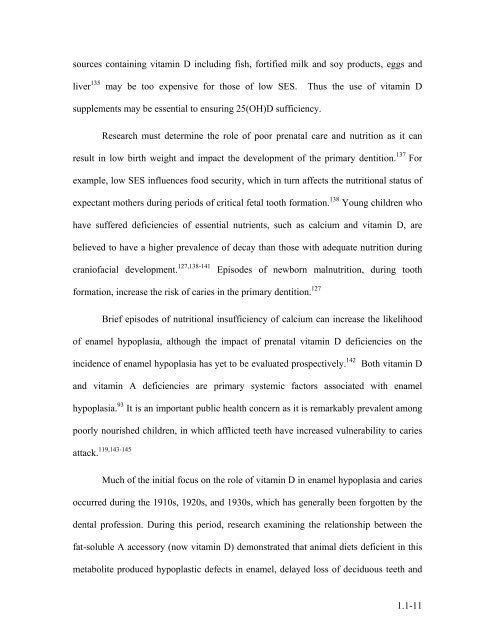Influence of Maternal Prenatal Vitamin D Status on Infant Oral Health
Influence of Maternal Prenatal Vitamin D Status on Infant Oral Health
Influence of Maternal Prenatal Vitamin D Status on Infant Oral Health
You also want an ePaper? Increase the reach of your titles
YUMPU automatically turns print PDFs into web optimized ePapers that Google loves.
sources c<strong>on</strong>taining vitamin D including fish, fortified milk and soy products, eggs and<br />
liver 135<br />
may be too expensive for those <str<strong>on</strong>g>of</str<strong>on</strong>g> low SES. Thus the use <str<strong>on</strong>g>of</str<strong>on</strong>g> vitamin D<br />
supplements may be essential to ensuring 25(OH)D sufficiency.<br />
Research must determine the role <str<strong>on</strong>g>of</str<strong>on</strong>g> poor prenatal care and nutriti<strong>on</strong> as it can<br />
result in low birth weight and impact the development <str<strong>on</strong>g>of</str<strong>on</strong>g> the primary dentiti<strong>on</strong>. 137 For<br />
example, low SES influences food security, which in turn affects the nutriti<strong>on</strong>al status <str<strong>on</strong>g>of</str<strong>on</strong>g><br />
expectant mothers during periods <str<strong>on</strong>g>of</str<strong>on</strong>g> critical fetal tooth formati<strong>on</strong>. 138 Young children who<br />
have suffered deficiencies <str<strong>on</strong>g>of</str<strong>on</strong>g> essential nutrients, such as calcium and vitamin D, are<br />
believed to have a higher prevalence <str<strong>on</strong>g>of</str<strong>on</strong>g> decay than those with adequate nutriti<strong>on</strong> during<br />
crani<str<strong>on</strong>g>of</str<strong>on</strong>g>acial development. 127,138-141<br />
Episodes <str<strong>on</strong>g>of</str<strong>on</strong>g> newborn malnutriti<strong>on</strong>, during tooth<br />
formati<strong>on</strong>, increase the risk <str<strong>on</strong>g>of</str<strong>on</strong>g> caries in the primary dentiti<strong>on</strong>. 127<br />
Brief episodes <str<strong>on</strong>g>of</str<strong>on</strong>g> nutriti<strong>on</strong>al insufficiency <str<strong>on</strong>g>of</str<strong>on</strong>g> calcium can increase the likelihood<br />
<str<strong>on</strong>g>of</str<strong>on</strong>g> enamel hypoplasia, although the impact <str<strong>on</strong>g>of</str<strong>on</strong>g> prenatal vitamin D deficiencies <strong>on</strong> the<br />
incidence <str<strong>on</strong>g>of</str<strong>on</strong>g> enamel hypoplasia has yet to be evaluated prospectively. 142<br />
Both vitamin D<br />
and vitamin A deficiencies are primary systemic factors associated with enamel<br />
hypoplasia. 93 It is an important public health c<strong>on</strong>cern as it is remarkably prevalent am<strong>on</strong>g<br />
poorly nourished children, in which afflicted teeth have increased vulnerability to caries<br />
attack. 119,143-145<br />
Much <str<strong>on</strong>g>of</str<strong>on</strong>g> the initial focus <strong>on</strong> the role <str<strong>on</strong>g>of</str<strong>on</strong>g> vitamin D in enamel hypoplasia and caries<br />
occurred during the 1910s, 1920s, and 1930s, which has generally been forgotten by the<br />
dental pr<str<strong>on</strong>g>of</str<strong>on</strong>g>essi<strong>on</strong>. During this period, research examining the relati<strong>on</strong>ship between the<br />
fat-soluble A accessory (now vitamin D) dem<strong>on</strong>strated that animal diets deficient in this<br />
metabolite produced hypoplastic defects in enamel, delayed loss <str<strong>on</strong>g>of</str<strong>on</strong>g> deciduous teeth and<br />
1.1-11







![an unusual bacterial isolate from in partial fulf]lment for the ... - MSpace](https://img.yumpu.com/21942008/1/190x245/an-unusual-bacterial-isolate-from-in-partial-fulflment-for-the-mspace.jpg?quality=85)





![in partial fulfil]ment of the - MSpace - University of Manitoba](https://img.yumpu.com/21941988/1/190x245/in-partial-fulfilment-of-the-mspace-university-of-manitoba.jpg?quality=85)


